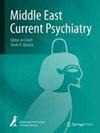Schizophrenia and family burden in Morocco: assessment in a sample of 150 caregivers
IF 1.6
Q3 PSYCHIATRY
引用次数: 0
Abstract
Abstract Background There have been few studies conducted in Africa about the burden on families of patients with schizophrenia. This study had two main objectives: assessing the burden of those families and identifying the socio-demographic factors associated with this one. Methods We included 300 participants: 150 were primary family caregivers of 150 patients with schizophrenia. A questionnaire was used to collect their sociodemographic and clinical characteristics, and their objective burden using the FBIS (Family Burden Interview Schedule). Results Patients were mostly men ( n = 122, 81%), the mean age was 32.4 years ± 10.1, and more than half of the patients were psychoactive substance users. Participants (caregivers) were mostly women ( n = 90, 60%). Their mean age was 51.9 ± 12.8 years, with a percentage of 62 (41%) illiteracy, while 98 (65%) were parents. The mean score of the family burden was 21.82 (0–48). The most affected categories were family routine, family interaction, and finances. The burden of families was associated with five sociodemographic variables: the female gender of the caregiver ( p = 0.01), the male gender of the patient ( p = 0.02), his young age ( p = 0,004), his education level ( p < 0.0001), and his psychoactive substance use (PAS) ( p < 0.000 1). Conclusion The three main constraints encountered by families caring for a patient with schizophrenia were disruption of daily activities, deterioration in the quality of family interactions with those around them, and lastly financial difficulties. These results highlighted the need to set up intermediary socio-medical structures, which would act as a link between conventional hospital services and families.摩洛哥精神分裂症和家庭负担:对150名护理人员样本的评估
背景在非洲很少有关于精神分裂症患者家庭负担的研究。这项研究有两个主要目的:评估这些家庭的负担和确定与此有关的社会人口因素。方法纳入300名受试者:150名精神分裂症患者的主要家庭照顾者。采用FBIS (Family burden Interview Schedule)问卷调查他们的社会人口学和临床特征,以及客观负担。结果患者以男性为主(n = 122,占81%),平均年龄(32.4±10.1)岁,半数以上为精神活性物质使用者。参与者(照顾者)主要是女性(n = 90,60 %)。平均年龄51.9±12.8岁,其中62人(41%)为文盲,98人(65%)为父母。家庭负担平均得分为21.82分(0 ~ 48分)。受影响最大的类别是家庭日常、家庭互动和财务状况。家庭负担与照顾者的女性(p = 0.01)、患者的男性(p = 0.02)、患者的年龄(p = 0.004)、受教育程度(p <0.0001),以及他的精神活性物质使用(PAS) (p <结论照顾精神分裂症患者的家庭遇到的三个主要制约因素是日常活动中断,与周围人的家庭互动质量下降,最后是经济困难。这些结果突出表明,有必要建立中间的社会医疗结构,作为传统医院服务和家庭之间的联系。
本文章由计算机程序翻译,如有差异,请以英文原文为准。
求助全文
约1分钟内获得全文
求助全文
来源期刊

Middle East Current Psychiatry
Medicine-Psychiatry and Mental Health
CiteScore
3.00
自引率
0.00%
发文量
89
审稿时长
9 weeks
 求助内容:
求助内容: 应助结果提醒方式:
应助结果提醒方式:


